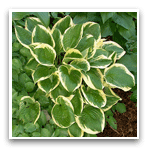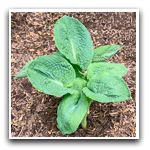 The major hosta species as defined by
W. George Schmid in
his 1991 book, The Genus Hosta:
Giboshi Zoku, originated in Japan, Korea and China.
Englebert Kaempfer (1651-1716) was the first Westerner
to visit Japan and make drawings of the plant we now know as
hosta although he did not bring any plants back to Europe.
He was followed by the Swedish plant explorer,
Carl Peter Thunberg (1743-1828) who visited Japan in
1775. A student of Linnaeus, he sent herbarium
specimens back to Sweden which included
H. lancifolia
and 'Undulata'.
The major hosta species as defined by
W. George Schmid in
his 1991 book, The Genus Hosta:
Giboshi Zoku, originated in Japan, Korea and China.
Englebert Kaempfer (1651-1716) was the first Westerner
to visit Japan and make drawings of the plant we now know as
hosta although he did not bring any plants back to Europe.
He was followed by the Swedish plant explorer,
Carl Peter Thunberg (1743-1828) who visited Japan in
1775. A student of Linnaeus, he sent herbarium
specimens back to Sweden which included
H. lancifolia
and 'Undulata'.
Hostas were first grown in
Europe from seeds sent from China to France before 1784.
They were planted in the
Jarden des Plantes in Paris. The first species was
the fragrant,
H. plantaginea which were know at the time as
Hemerocallis plantaginea. In 1790, H. plantaginea
and
H. ventricosa
were first imported to
England.
 Of all the famous plant explorers, the name of
Phillip von Siebold (1796-1866) is probably most associated with
the genus, Hosta. This German medical doctor went to
Japan in 1823 and began his botanical explorations in
addition to his work as a surgeon. Among the many plants he
discovered in the wild were H. tibae,
H. longissima,
H. lancifolia, H. 'Undulata', and H. 'Crispula'.
Upon his return, he became the first European to cultivate
hostas that originated in Japan. Two of the species he
brought were named in his honor,
Hosta sieboldii
and
Hosta sieboldiana (now H. 'Sieboldiana').
Of all the famous plant explorers, the name of
Phillip von Siebold (1796-1866) is probably most associated with
the genus, Hosta. This German medical doctor went to
Japan in 1823 and began his botanical explorations in
addition to his work as a surgeon. Among the many plants he
discovered in the wild were H. tibae,
H. longissima,
H. lancifolia, H. 'Undulata', and H. 'Crispula'.
Upon his return, he became the first European to cultivate
hostas that originated in Japan. Two of the species he
brought were named in his honor,
Hosta sieboldii
and
Hosta sieboldiana (now H. 'Sieboldiana').
A second trip to Japan in
1860-62 resulted in the introduction of H. 'Tokudama',
H. 'Undulata
Univittata', H. 'Fortunei
Albopicta', H. 'Undulata Erromena',
H. 'Fortunei Aurea',
H. 'Crispula Lutescens', H. 'Fortunei
Hyacinthina', H. 'Fortunei
Gigantea' and H. 'Fortunei Aoki' to Europe.
 Another English plant explorer who is prominent in the hosta
world is
Robert Fortune (1812-1880). He started at the
Royal Botanical Garden in Edinburgh and was sent on his
first plant expedition to China and Japan in 1860 where he
met von Siebold. During that meeting, he was given a plant
which became known as the species, Funkia fortunei
and later H. forutnei before it was transferred to cultivar
status by Schmid 1991 as H. 'Fortunei'.
Another English plant explorer who is prominent in the hosta
world is
Robert Fortune (1812-1880). He started at the
Royal Botanical Garden in Edinburgh and was sent on his
first plant expedition to China and Japan in 1860 where he
met von Siebold. During that meeting, he was given a plant
which became known as the species, Funkia fortunei
and later H. forutnei before it was transferred to cultivar
status by Schmid 1991 as H. 'Fortunei'.



